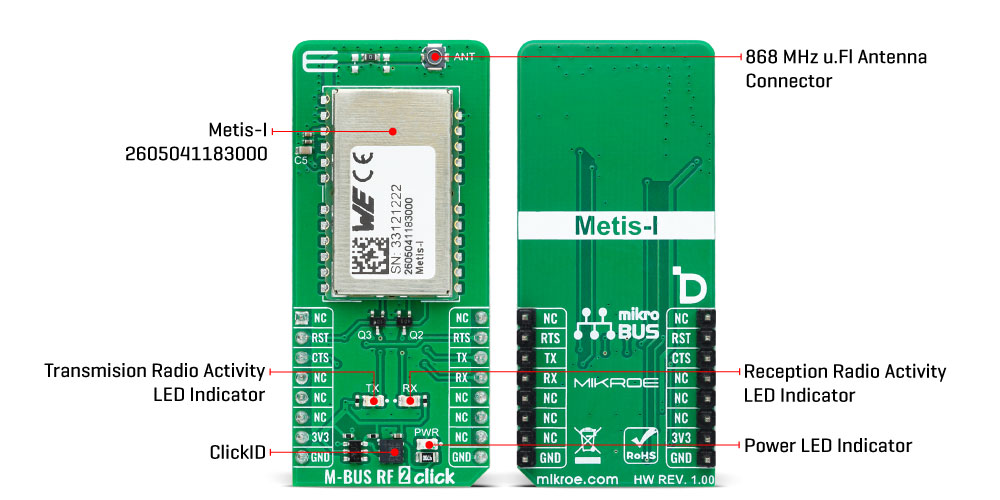OFF
GO LOCAL
| Company | Stock | Price |
|---|---|---|

MIKROE-3303
22 g
Status:
M-BUS RF 2 Click is a compact add-on board designed for utility metering and various telemetry applications. This board features the Metis-I (2605041183000), an 868MHz radio module from Würth Elektronik. It integrates an MSP430 microcontroller and a CC1101 RF chip-set to ensure efficient data transmission. Key features include a frequency range of 868.3MHz to 869.525MHz, support for the Wireless M-BUS EN13757-4:2013 and Open Metering System (OMS) standards, and communication capabilities up to 700 meters in clear conditions. The board also offers energy-saving functionalities such as Wake-On-Radio, an output power of +11dBm output, and AES-128 encryption for secure communication. This Click board™ is ideal for developers looking to implement advanced wireless communication systems in smart metering, home automation, and industrial control.
M-BUS RF 2 Click is fully compatible with the mikroBUS™ socket and can be used on any host system supporting the mikroBUS™ standard. It comes with the mikroSDK open-source libraries, offering unparalleled flexibility for evaluation and customization. What sets this Click board™ apart is the groundbreaking ClickID feature, enabling your host system to seamlessly and automatically detect and identify this add-on board.
This product is no longer in stock
Availability date:
OFF
| Company | Stock | Price |
|---|---|---|

M-BUS RF 2 Click is based on the Metis-I (2605041183000), a radio module from Würth Elektronik, operating at 868MHz frequency. This module integrates an MSP430 microcontroller and a CC1101 RF chip-set, providing a powerful yet low-cost communication solution. The Metis-I module has a range of impressive features. Operating on a frequency band of 868MHz, it is also equipped with a 32768B Flash memory and 1024B RAM. It adheres to the Wireless M-BUS EN13757-4:2013 standard and supports the Open Metering System (OMS), ensuring broad compatibility in utility metering applications. The module can communicate effectively over distances up to 700 meters under clear conditions and is designed with energy efficiency in mind, including a Wake-On-Radio feature that reduces power consumption. Additionally, it has an output power of +11dBm and an RF sensitivity of up to -103dBm for robust wireless transmission.

Communication between the Metis-I and the host MCU is made through a UART interface, using the standard UART RX and TX pins and hardware flow control pins (CTS/RTS). The module communicates at 115200bps by default, allowing efficient data exchange. The board also includes a reset (RST) pin for resetting the module. There are two LED indicators for user interaction: an orange TX LED signaling transmission activity and a yellow RX LED indicating reception.
The board is designed to interface with 868MHz antennas, such as the Rubber 868MHz Antenna offered by MIKROE. It includes a u.Fl connector, necessitating an IPEX-SMA cable adapter, also available from MIKROE, to ensure proper antenna connection.
This Click board™ can be operated only with a 3.3V logic voltage level. The board must perform appropriate logic voltage level conversion before using MCUs with different logic levels. Also, it comes equipped with a library containing functions and an example code that can be used as a reference for further development.
Type
Sub-1 GHz Transceievers
Applications
Ideal for wireless communication systems in smart metering, home automation, and industrial control
On-board modules
Metis-I (2605041183000) - radio module from Würth Elektronik
Key Features
868MHz operating frequency, module based on the MSP430 MCU and CC1101 RF chip-set, integrated Flash and RAM, wireless M-BUS EN13757-4:2013 standard, OMS (Open Metering System) supported, range up to 700m line of sight, low-power function (Wake-On-Radio), UART interface with additional hardware flow control pins, and more
Interface
UART
Feature
ClickID
Compatibility
mikroBUS™
Click board size
L (57.15 x 25.4 mm)
Input Voltage
3.3V
This table shows how the pinout on M-BUS RF 2 Click corresponds to the pinout on the mikroBUS™ socket (the latter shown in the two middle columns).
| Label | Name | Default | Description |
|---|---|---|---|
| LD1 | PWR | - | Power LED Indicator |
| LD2 | RX | - | Reception Radio Activity LED Indicator |
| LD3 | TX | - | Transmission Radio Activity LED Indicator |
| Description | Min | Typ | Max | Unit |
|---|---|---|---|---|
| Supply Voltage | - | 3.3 | - | V |
| Frequency Range | - | 868 | - | MHz |
| Range (Line of Sight) | - | - | 700 | m |
| Output Power | - | - | +11 | dBm |
| Sensitivity | - | - | -103 | dBm |
We provide a library for the M-BUS RF 2 Click as well as a demo application (example), developed using MIKROE compilers. The demo can run on all the main MIKROE development boards.
Package can be downloaded/installed directly from NECTO Studio Package Manager(recommended), downloaded from our LibStock™ or found on Mikroe github account.
Library Description
This library contains API for M-BUS RF 2 Click driver.
Key functions
mbusrf2_set_rst_pin This function is used to set reset pin state.
mbusrf2_send_command This function is used to send a desired command.
mbusrf2_send_data This function is used to data in transmitter mode.
Example Description
This example demonstrates the use of M-BUS RF 2 click board by processing the incoming data and displaying them on the USB UART.
void application_task ( void )
{
mbusrf2_example( );
}
The full application code, and ready to use projects can be installed directly from NECTO Studio Package Manager(recommended), downloaded from our LibStock™ or found on Mikroe github account.
Other Mikroe Libraries used in the example:
Additional notes and informations
Depending on the development board you are using, you may need USB UART click, USB UART 2 Click or RS232 Click to connect to your PC, for development systems with no UART to USB interface available on the board. UART terminal is available in all MIKROE compilers.
This Click board™ is supported with mikroSDK - MIKROE Software Development Kit. To ensure proper operation of mikroSDK compliant Click board™ demo applications, mikroSDK should be downloaded from the LibStock and installed for the compiler you are using.
For more information about mikroSDK, visit the official page.
NOTE: Please be advised that any peripheral devices or accessories shown connected to the Click board™ are not included in the package. Check their availability in our shop or in the YMAN section below.